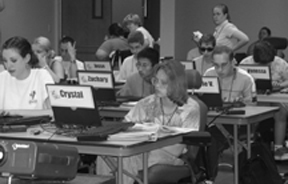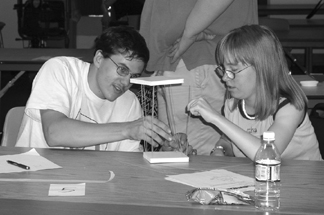Summer Study '03: What Do the Phase I Scholars Do?
DO-IT Phase I Scholars participate in a two-week, live-in Summer Study session on the University of Washington campus in Seattle, Washington. They learn about college life; surf the Internet; interact with peers, staff, and mentors; and have fun. Below, '03 Phase I Scholars share some of their experiences. Note that, reluctantly, some articles were edited by DO-IT staff to make them short enough to include in this publication. Additional articles by Scholars can be found in earlier newsletters at www.washington.edu/doit/news/do-it-news.
Self-Determination
by Scholars Crystal and Jamie G.
How do you get self-determination? Where does it come from? Why do some people have more than others? Thanks to DO-IT, we are now able to answer these questions. Self-determination comes from within yourself; no one else can make you achieve your dreams. Success, motivation, goals, and strategies are all key components in self-determination.
On our first day of Summer Study, we were introduced to this valuable lesson. We opened up the activity by defining self-determination. One of the best examples we heard was "having the will to reach your goals, regardless of the challenges or limitations you may face." Another excellent point made several times during the class was to recognize your weaknesses and focus on your strengths. When you are able to work through your weaknesses by doing something you excel at, then you have reached a major objective. We must not sit back and let others tell us what we want for ourselves; we have to take the initiative and speak up.
In order to have self-determination you have to believe in yourself, and you need others to have confidence in you. Don't give up on anything you dream for yourself. If you fail, at least you know you gave it everything you've got.

Computers for DO-IT Scholars
by Scholars Jamie V. and Zach
The DO-IT Scholars program at the University of Washington loans a laptop to each Scholar to use as long as they actively participate in DO-IT. How cool is that? This incredible gift helps every Scholar with school work, and allows everyone to communicate with other Scholars and disabled people around the world. DO-IT receives state, federal, and corporate support and also relies on generous people who donate time and money.
University of Washington technology specialist Doug Hayman provides training to new Scholars on how to use the computer, anti-virus software, and the Microsoft Windows Update site. This helps keep the laptop in great running condition.
Thanks to everyone who donates to DO-IT, as they changed the lives of 22 young Scholars in this year alone.
Working with Sign Language Interpreters
by Scholars Norma and Theresa
How do people who are deaf communicate with hearing people, and what is the role of the interpreter? These questions are hard to answer. The interpreter uses sign language to communicate what teachers, students, and friends say to the deaf person. Deaf and hard-of-hearing people also write notes to communicate with hearing people when they don't have an interpreter. The interpreter plays an important role when communicating with a deaf person. Their vocabulary skills need to be really good. One thing that matters to deaf people is for the interpreter to match the effect of the hearing person's voice. Interpreters need to show effect, both in their signing and on their face.
Some hearing people think that people who are deaf cannot do anything, but that isn't true. Just because a person cannot hear does not mean he cannot think. Some deaf people can even answer the phone and drive a car. There are different ways that a deaf person knows whether to answer the phone or the doorbell. The phone flash is moderately slow, but the doorbell flash is fast. When either one goes off, a deaf person can tell which one it is. In conclusion, deaf people are awesome.

Engineering Basics
by Scholars Natasha and Annemarie
The DO-IT Phase I Scholars participated in a workshop explaining the various fields of engineering. They were honored to have one of the engineering professors from the University of Washington join them. After a brief discussion about what kinds of jobs engineers do, the professor led a hands-on activity to demonstrate a typical civil engineering project.
The Scholars were given two five-inch by five-inch foam squares, twenty sticks of raw spaghetti, and twenty-four inches of masking tape. With these materials, they were asked to build a water tower. Scholars worked in groups of three or four for about an hour. As a tip, the professor taught the four S's of engineering: strength, symmetry, stability, and simplicity. Once the towers were built, they were set on a scale with a cup acting as the water tank on top. Water was poured in the cup until the tower broke. The tower named The Beast, with diamond and triangle shaped bracing, took first place, holding over 800 grams of water. Enforced Public Art took second place with its design of triangles and X's, and it held over 300 grams.
The competition was enjoyed by all as the Scholars got a chance to display their engineering skills and explore some different fields of work.
What Mentors Can Do for You
by Scholars Vanessa and Matt
Mentors are important for everybody, especially teenagers. Mentors can give advice when you need it. Mentors have been through experiences that some young people are going through now. They can also be a good resource. DO-IT has a group of adults who mentor the Scholars.
The DO-IT Mentors answer questions that the Scholars have. They can answer these questions because they have been through similar situations with different types of disabilities and are now participating in college or careers. Some Mentors are pursuing careers in science, technology, engineering, and mathematics and can answer questions in these areas. The Mentors answer a lot of the questions from the Scholars using email. Sometimes they meet Scholars in person.
Here are some questions that Scholars might ask Mentors to answer:
- What challenges did you have to overcome to get into your career and where you are now?
- What have you done to overcome the challenges associated with your disability?
- What made you think that you wanted to be in this field instead of something else?
- What do you like most about your career?
- What do you not like about your career (if anything)?
Mentors are a big part of the support system in DO-IT.
Scholars Perform Heart Bypass Surgery
by Scholars Conrad and Patrick
Heart dissections may seem gross and unnecessary, but they can be quite interesting and informative. At Summer Study '03, Phase I Scholars had the opportunity to perform mock heart surgeries using real sheep hearts. The Scholars attempted two different kinds of heart surgery.
The first surgery was a bypass operation. To complete the bypass, Scholars used a razor blade to make two precise incisions, one above a mock blockage, and the other below the blockage. Scholars then inserted a rubber tube into each incision, thus bypassing the blockage.
After the Scholars finished the bypass surgery on the sheep heart, they then proceeded to the second surgery. In this surgery, they had to insert a piece of chalk into the right aorta. First, the Scholars started by making a large incision into the right aorta. Then they inserted the chalk in the incision. After the chalk was in place, each group of Scholars felt for the chalk to determine where it ended and how far they had got it in.
When that was all done, the Scholars had the opportunity to cut open the sheep heart and peek inside. Our group cut the heart open perfectly and we felt around. The inside felt basically the same as the outside, which was kind of rubbery and slippery. We also found the chalk that we had inserted.
We are not sure how this surgery would compare to the real thing, but it was a good, hands-on experience.
DO-IT Does the Zoo
by Scholar Justin
It was a beautiful Sunday morning, one in which everyone got up very late after a long Saturday. However, everyone who was there took the idea of the zoo as a mixed blessing. Half the Scholars just couldn't wait to go, while the other half (myself included) were rather hesitant. Anyway, at a quarter to ten, all of us left for the zoo.
The trip started out well enough; Phase II Scholars presented to us their year-long projects, and they did quite well. After pizza and a chance to see an owl, we were off to explore the zoo. To be honest, the zoo started rather slow. In fact, it is a theory of mine that we arrived there when it was "nap time" for the animals. However, by the time we reached the nightlife house, things started to pick up (though I wish to forget about the rain forest since it was very hard to breathe in there).
Going to Microsoft
by Scholar Patrick
I enjoyed going to Microsoft and would recommend it for all incoming DO-IT Scholars. At Microsoft, we saw many things. We learned about lots of new jobs and how movies are made. Also, getting a chance to shop at the store is neat because you can get some really good deals there. The tour could have been improved by visiting more areas, or other buildings. I also wanted to meet Bill Gates, which would have been fun, but maybe unrealistic.
The Pacific Science Center (and Many of Its Attractions)
by Scholars Shaun and Andrew
The Pacific Science Center was a fun and interesting experience. The Science Center is very overwhelming at first because of its immense size and multiple buildings. Some may find it just educational, which it is, but as we will explain in the following paragraphs, it is also fun.
The Minor Attractions
Some of the best minor attractions were the cone checkers, the giant chess set, and the dinosaur exhibit. The cone checkers were really different from a normal checker set. Featured were large construction cones painted red and black. The board was like a large throw rug, but standard rules still applied. The giant chess set was acutely true to its smaller counterpart, but we didn't play chess while at the Science Center. Lastly, the dinosaur exhibit was very informative and realistic looking. We expected the dinosaurs to jump out and attack us!
The Major Attractions
The IMAX Theater was very oversized compared to a standard theater. The screen was six stories high and eighty feet wide, which we might add is very intimidating to look at. The room it sat in was more of a huge concert hall than a theater. The speakers seemed to cover the walls. The theater itself is in a dome. The overall look of the theater seemed like a football stadium. The movie Ghosts of the Abyss was like being at the site of the wreck of the Titanic. It was awe-inspiring, and very creepy, looking at a site where so many people died. It was scary, yet interesting at the same time, to see the Titanic sitting in its underwater grave, just staring back at us through the screen.
The Laser Dome
The Laser Dome was a different kind of experience. It was really cool to see such a high quality laser show even though the music was a bit too "poppy." We think we should have come to the evening show which included music from Pink Floyd, ZZ Top, and Radiohead. The amazing colors, designs, and improv were awesome. The way the lights formed shapes, lines, and even people gave a feeling that is hard to explain.